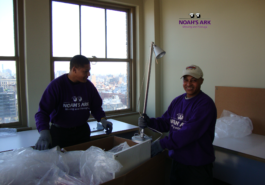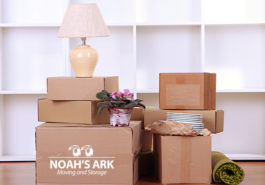 A Positively Moving Experience
A Positively Moving Experience

Best Box Wrapping Techniques

Properly wrapping boxes when you’re moving is an absolute must if you intend on all your belongings being safely transported to your new location. Fortunately, the expert movers at Noah’s Ark have prepared a foolproof list of guidelines for you to ensure that all your belongings emerge from their moving boxes into your new location as good as when you first placed them inside.
Use properly sized boxes
Heavy objects like books or glass should be placed in small boxes, however light objects like fabric or blankets should be packed inside big boxes. Huge boxes full of heavy materials are very difficult to transport, and not only make the job harder for you or your moving assistants, but increase the chances of a breakage.
Stack items heaviest side on the bottom
Make sure to put all heavier objects on the bottom of the box and all lighter items on the top. If you’re loading the truck full of packed boxes, put the heaviest objects in the front of the truck first. This is to maximize stability and balance.
Leave no empty pocket unpacked!
Make sure that all gaps in moving boxes are filled up, either with clothing, towels or even packing paper if need be. Loosely packed boxes increase the chances of objects shifting around and getting damaged.
Pack Boxes According to Room
Make sure that you label all boxes with their contents and what room they belong in. This will make it easier for you or your moving assistants to unload the truck, as well as increasing the efficiency of the packing and unpacking operation. You can also keep a detailed list of your objects to make sure you still have all your belongings when you unpack.
Secure Boxes with Tape
Make sure that both above and below seams in boxes are secured well with tape, and then wrap tape around the top and bottom corners of the box, where the stress is placed.
Use special crates for Artwork
Don’t wrap up any oil paintings inside regular packing paper, as they will likely stick to the art’s fragile surface. Use an X shaped masking tape structure to strengthen glass framed photos, and then wrap up the frames in bubble wrap, and inside a specialty frame box, with cardboard behind each side to further protect it.
Place Breakables Together – Individually
This might seem like an oxymoron, but make sure to place packing paper around each dish individually, and then wrap a bunch of individually wrapped dishes up together. Stack dishes on their sides, as opposed to flat, as they are stronger that way – and place padded up paper above and below them for additional protection. Put cups and bowls inside each other, again, with paper wrapped individually around pieces, in bundles of 3 or 4 – and put all dishes into specialty dish barrel boxes.










